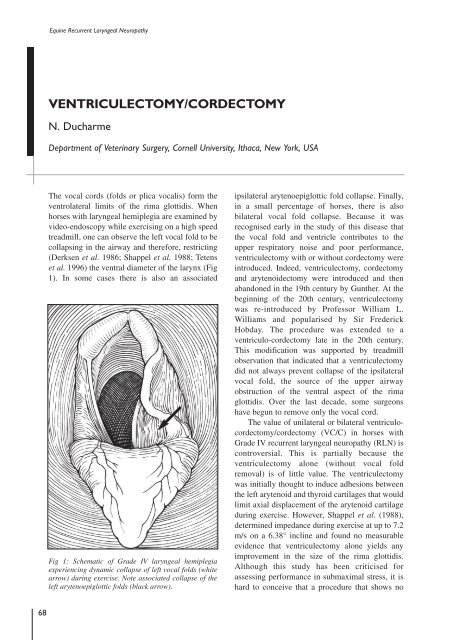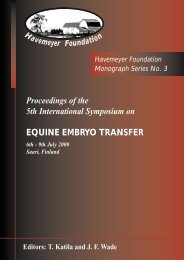Proceedings of a Workshop on - The Havemeyer Foundation
Proceedings of a Workshop on - The Havemeyer Foundation
Proceedings of a Workshop on - The Havemeyer Foundation
You also want an ePaper? Increase the reach of your titles
YUMPU automatically turns print PDFs into web optimized ePapers that Google loves.
Equine Recurrent Laryngeal Neuropathy<br />
VENTRICULECTOMY/CORDECTOMY<br />
N. Ducharme<br />
Department <str<strong>on</strong>g>of</str<strong>on</strong>g> Veterinary Surgery, Cornell University, Ithaca, New York, USA<br />
<strong>The</strong> vocal cords (folds or plica vocalis) form the<br />
ventrolateral limits <str<strong>on</strong>g>of</str<strong>on</strong>g> the rima glottidis. When<br />
horses with laryngeal hemiplegia are examined by<br />
video-endoscopy while exercising <strong>on</strong> a high speed<br />
treadmill, <strong>on</strong>e can observe the left vocal fold to be<br />
collapsing in the airway and therefore, restricting<br />
(Derksen et al. 1986; Shappel et al. 1988; Tetens<br />
et al. 1996) the ventral diameter <str<strong>on</strong>g>of</str<strong>on</strong>g> the larynx (Fig<br />
1). In some cases there is also an associated<br />
Fig 1: Schematic <str<strong>on</strong>g>of</str<strong>on</strong>g> Grade IV laryngeal hemiplegia<br />
experiencing dynamic collapse <str<strong>on</strong>g>of</str<strong>on</strong>g> left vocal folds (white<br />
arrow) during exercise. Note associated collapse <str<strong>on</strong>g>of</str<strong>on</strong>g> the<br />
left arytenoepiglottic folds (black arrow).<br />
ipsilateral arytenoepiglottic fold collapse. Finally,<br />
in a small percentage <str<strong>on</strong>g>of</str<strong>on</strong>g> horses, there is also<br />
bilateral vocal fold collapse. Because it was<br />
recognised early in the study <str<strong>on</strong>g>of</str<strong>on</strong>g> this disease that<br />
the vocal fold and ventricle c<strong>on</strong>tributes to the<br />
upper respiratory noise and poor performance,<br />
ventriculectomy with or without cordectomy were<br />
introduced. Indeed, ventriculectomy, cordectomy<br />
and arytenoidectomy were introduced and then<br />
aband<strong>on</strong>ed in the 19th century by Gunther. At the<br />
beginning <str<strong>on</strong>g>of</str<strong>on</strong>g> the 20th century, ventriculectomy<br />
was re-introduced by Pr<str<strong>on</strong>g>of</str<strong>on</strong>g>essor William L.<br />
Williams and popularised by Sir Frederick<br />
Hobday. <strong>The</strong> procedure was extended to a<br />
ventriculo-cordectomy late in the 20th century.<br />
This modificati<strong>on</strong> was supported by treadmill<br />
observati<strong>on</strong> that indicated that a ventriculectomy<br />
did not always prevent collapse <str<strong>on</strong>g>of</str<strong>on</strong>g> the ipsilateral<br />
vocal fold, the source <str<strong>on</strong>g>of</str<strong>on</strong>g> the upper airway<br />
obstructi<strong>on</strong> <str<strong>on</strong>g>of</str<strong>on</strong>g> the ventral aspect <str<strong>on</strong>g>of</str<strong>on</strong>g> the rima<br />
glottidis. Over the last decade, some surge<strong>on</strong>s<br />
have begun to remove <strong>on</strong>ly the vocal cord.<br />
<strong>The</strong> value <str<strong>on</strong>g>of</str<strong>on</strong>g> unilateral or bilateral ventriculocordectomy/cordectomy<br />
(VC/C) in horses with<br />
Grade IV recurrent laryngeal neuropathy (RLN) is<br />
c<strong>on</strong>troversial. This is partially because the<br />
ventriculectomy al<strong>on</strong>e (without vocal fold<br />
removal) is <str<strong>on</strong>g>of</str<strong>on</strong>g> little value. <strong>The</strong> ventriculectomy<br />
was initially thought to induce adhesi<strong>on</strong>s between<br />
the left arytenoid and thyroid cartilages that would<br />
limit axial displacement <str<strong>on</strong>g>of</str<strong>on</strong>g> the arytenoid cartilage<br />
during exercise. However, Shappel et al. (1988),<br />
determined impedance during exercise at up to 7.2<br />
m/s <strong>on</strong> a 6.38° incline and found no measurable<br />
evidence that ventriculectomy al<strong>on</strong>e yields any<br />
improvement in the size <str<strong>on</strong>g>of</str<strong>on</strong>g> the rima glottidis.<br />
Although this study has been criticised for<br />
assessing performance in submaximal stress, it is<br />
hard to c<strong>on</strong>ceive that a procedure that shows no<br />
68








